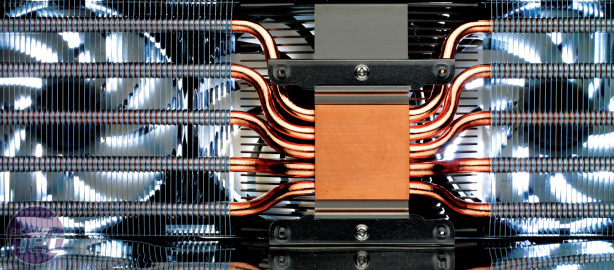Graphics Card Coolers Investigated
May 19, 2010 | 08:19
Companies: #akasa #alpenfohn #arctic-cooling #scythe #thermalright

Graphics Card Cooling On Test
Ever since the days of the Dustbuster, Nvidia's infamous GeForce FX 5800, graphics cards have had the potential to be the noisiest components in any PC. ATI’s HD 4000 series and Nvidia’s GTX 200 series hardware in particular have seen people reach for waterblocks in their thousands in an attempt to quieten their PCs, lower their graphics card’s operating temperatures and to get some more overclocking headroom.ATI’s HD 5000-series runs much cooler and quieter than the HD 4000-series but this hasn’t stopped third-party graphics card cooler manufacturers scrambling to get coolers out the door that support the new king of hill - and don't get us started on how hot Fermi is.
You might think that dealing with a toasty, noisy graphics card is just a case of swapping the heatsink for another - but sadly, all is not well in the land of third-party coolers. We recently tested 11 of the latest third-party coolers, pitting them against the stock coolers of the HD 4890, HD 5870 and the GTX 280 to see if there’s a cheaper and easier alternative to water-cooling and were horrified by the results.

Third-party coolers often look the business, but how do they actually perform?
As you'll see over the next few pages, these coolers are often expensive, finger-mangling and frequently fail to significantly outperform the stock coolers. Only two of the 11 coolers we tested was good enough to earn our praise - and one has been discontinued, while the other lacks compatibility with many modern graphics cards. If you're thinking about replacing the HSF of your graphics card, this article should give you pause for thought.
The Line-Up
We sourced 11 different coolers for our testing:- Akasa AK-VC05 Freedom Force
- Akasa Vortexx Neo
- Alpenfohn Heidi
- Arctic Cooling Accelero S1 Rev 2 (With Turbo Module)
- Arctic Cooling GTX Pro
- Arctic Cooling L2 Pro
- Arctic Cooling Twin Turbo Pro
- Scythe Musashi
- Scythe Setsugen*
- Thermalright Spitfire (with VRM-R2 heatsink)
- Thermalright Trad2
How We Tested
As with CPU coolers, the single most important factor to consider with graphics card coolers is how well they cool your graphics card. In addition to the GPU core, the RAM and VRMs on the PCB also become very hot under load. If they overheat, your graphics card will crash and may even die.To measure the core temperature of the graphics card on test, we used GPU-Z and a multimeter to measure the ambient air temperature at the intakes of the Antec Nine Hundred Two case we used for testing. As we don’t test in a temperature-controlled lab, we measured the difference between the ambient air temperature and the absolute temperature recorded by GPU-Z. The difference is called the delta T and allows a comparison to be made between results if the ambient temperature fluctuates.
As all graphics cards are equipped with a stock cooler, we also tested this in the same way to gauge how well the third-party coolers work in terms of both cooling and noise reduction, as the graphics card is often the noisiest component in a PC.
As graphics cards vary so much in shape, size and PCB layout, most third-party coolers are only compatible with a specific range of cards. To obtain an even playing field between the coolers, each was tested on the graphics card with the highest TDP it supports. This meant that testing was carried out on a Radeon HD 4890, Radeon HD 5870 and GeForce GTX 280.
We recorded the idle GPU temperature ten minutes after the graphics card was installed. We then used Furmark to load the GPU. FurMark is a very intensive OpenGL benchmark that uses fur-rendering algorithms to measure the performance of the graphics card. It provides a worst-case scenario to test if a graphics card cooler is able to cope with the GPU at maximum load. However, as FurMark doesn’t stress a graphics card’s memory as much as a game, we also ran a ten-minute loop of a Crysis timedemo in order to check that the memory was being sufficiently cooled.
Our test system included a Intel Core 2 Quad Q6600 cooled using a Cooler Master Hyper TX2 cooler, a Foxconn P45A-S motherboard, 2GB Corsair of DDR2 memory, a 320GB Western Digital hard disk, an Antec TruePower New TP-650 PSU and an Antec Nine Hundred Two case. Testing was carried out with the side panel attached and with all the case fans set to low speed. We used Windows 7 64-bit, GPU-Z v0.3.8, Furmark v1.8.0 and Crysis patched to version 1.2.1.

MSI MPG Velox 100R Chassis Review
October 14 2021 | 15:04








Want to comment? Please log in.